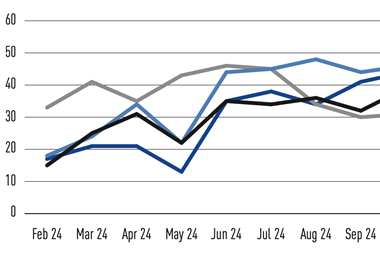In keeping with the trend for restructuring that has become the buzzword for those who believe Japan has turned a corner, there is substance to the reform of corporate pensions and significant momentum behind moves to introduce some form of defined contribution system.
Japan’s pension market is characterised by the narrow focus of global balanced mandates, hemmed in by the 5:3:3:2 asset allocation rules. The recent abolition of 5:3:3:2 means plans can now allocate assets based on their liabilities, which has allowed them to look at investment advisers, including the foreign names.
Historically, the overwhelming majority of assets were managed by eight domestic trust banks and 15 domestic life insurers. Mandates were awarded based on group affiliation, cross shareholding or customer relationships. Most plan sponsors lacked investment policies, which meant there were no target allocations and no meaningful performance comparisons. The opening up of competition is reflected in a shift from balanced to specialist management; from life insurance general accounts to marketable securities investment, and most importantly to higher equity and international exposure.
Nonetheless, trust banks and insurance companies still dominate the management of pension assets. Trust banks now have the upper hand due to the reduction in the guaranteed rate of return on pension accounts run by insurance companies, now just 1.5%.
There are 14 actuarial consultingfirms operating in Tokyo and the level of search activity is reportedly unprecedented. Wyatts and Daiwa have contracts with corporate pension funds to develop 401k-type plans, pending enabling legislation, which may be a couple of years away. Draft legislation will be put before parliament in July, and hopefully implemented early next year. But it would be wrong to expect a wholesale transition from DB to DC.
The one area where we will see some activity is the approach adopted by multinationals. Companies with Japanese subsidiaries may quickly adopt DC plans, where this is in line with group policy. The availability of a transportable international pension would certainly be taken up by any multinationals operating with the Japanese environment. Nobuyuki Uwamori at consultants Curuby & Co feels the advent of DC would be attractive for foreign affiliated firms as they will be looking for ways to reduce their pension costs by shifting at least a portion of their retirement allowance benefits into a DC form.
However, in the absence of a global group policy regarding DC, which can be used as a fundamental argument for a regional shift, multinationals are likely to be embroiled in the Japanese debate, just like other corporations. Some firms, such as IBM and Exxon, for example, have a system which defines what they will do within the confines of local legislation. If the Japanese system allows them to have a local policy that conforms to a global policy, they would be able to tell their employees “this is the reason we’re doing it”. If they don’t, Uwamori suggests it could be argued they are in effect shirking their responsibilities in terms of funding. As the issue obtains a higher profile, it is likely to highlight those who would seek to act in their own interests.
The pension council of the ministry of health and welfare recommended the introduction of DC into corporate pensions in its report of October 1998. The MHW, with the ministries of finance, international trade and industry and labour, began jointly working on the practicalities of introducing DC pensions. They expect to reach a conclusion by July and introduce a bill to parliament, beginning in January 2000. The DC system will not replace DB, but run alongside it.
Some of the big financial groups are working on developing an administration platform for DC plans. The biggest of these is the venture between Mitsubishi and Sumitomo. IBJ and Nomura have also teamed up and have now been joined by State Street and Mitsui Trust. Again, this is all a bit “cart before the horse”. It’s one thing to try to develop an admin capability, but Japan has Y2K problems of epic proportions to deal with first.
Nagatoshi Shimamura at Fuji Bank explains that because Japan’s pension infrastructure is 15 years behind the US, at least, the concept of master trusts has not yet been established, so a single Japanese pension scheme can use four trust banks. “Erisa-type regulations have not been fully developed yet. We are trying to introduce the 401k idea and all of the Japanese trust banks are looking at how to deal with the practical implications, in terms of administration and actuarial services. A small trust bank will not be able to cope by itself,” he says.
Japan’s Pension Market to 2005 by Curuby & Co in Tokyo offers a detailed guide to the developments. It is available price $350 from ISI in Hong Kong. Fax: +852-2877 0942.
Richard Newell is a director of Forsyth Partners












No comments yet